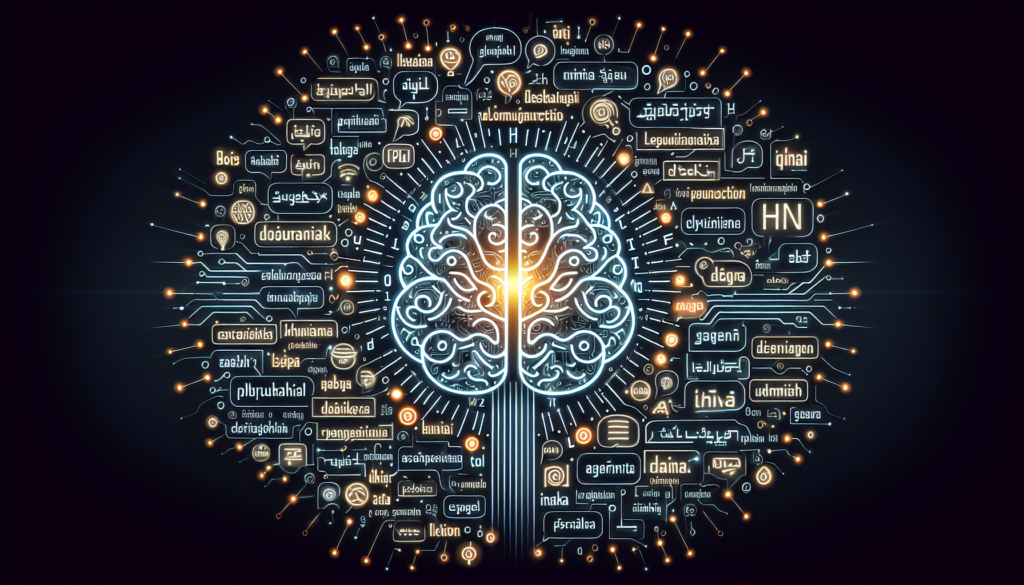Posts Tagged: Beginners


Demystifying Natural Language Processing: A Comprehensive Guide for Beginners
If you’ve ever wondered about the fascinating world of Natural Language Processing (NLP), look no further. In “Demystifying Natural Language Processing: A Comprehensive Guide for Beginners,” we aim to break down this complex subject into easily digestible pieces. From its definition to its applications, we’ll guide you through the basics of NLP in a friendly and approachable manner. Whether you’re just starting out or already have some knowledge in the field, this comprehensive guide will provide valuable insights and practical tips that will leave you craving for more. So, let’s embark on this journey together and uncover the wonders of Natural Language Processing.
What is Natural Language Processing?
Definition of Natural Language Processing
Natural Language Processing (NLP) is a field of study that focuses on the interaction between computers and human language. It involves the development of algorithms and models to enable computers to understand, interpret, and generate human language in a way that is useful and meaningful.
Importance of Natural Language Processing
Natural Language Processing plays a crucial role in bridging the gap between human communication and computer understanding. Advancements in NLP have revolutionized various industries by enabling machines to process human language for information extraction, sentiment analysis, speech recognition, and many other applications. By leveraging NLP techniques, businesses can gain valuable insights from vast amounts of text data, automate customer service through chatbots, and enhance language-based human-computer interactions.
Applications of Natural Language Processing
NLP has a wide range of applications across various domains. It is used in information retrieval systems to analyze and index text documents. Sentiment analysis and opinion mining, powered by NLP, help companies understand customer feedback and monitor social media sentiment. Machine translation enables automated translation between different languages. NLP techniques are also employed in question-answering systems, chatbots, speech recognition, and text summarization. The applications of NLP continue to expand as technology advances.
History of Natural Language Processing
Origins of Natural Language Processing
The origins of Natural Language Processing can be traced back to the 1950s when computer scientists began exploring ways to enable machines to understand and process language. The early focus was on developing language translation systems, but as the field progressed, researchers realized the complexity and challenges involved in accurately capturing the nuances of human language.
Milestone Developments in Natural Language Processing
Over the years, significant milestones have marked the progress of Natural Language Processing. In 1950, Alan Turing proposed the “Turing Test” as a measure of machine intelligence in language understanding. In the 1960s and 1970s, early attempts at machine translation and language understanding systems were made. The 1980s brought advances in syntax-based parsing algorithms. The 1990s witnessed the emergence of statistical approaches to language processing, with research focusing on machine learning techniques.
Advancements in Natural Language Processing
With the proliferation of vast amounts of digital data and the advancements in computing power, Natural Language Processing has witnessed tremendous progress in recent years. Deep learning models, such as recurrent neural networks (RNNs) and transformer models, have significantly improved language understanding capabilities. NLP techniques have become more accessible, with the development of open-source libraries and frameworks, empowering developers to incorporate language processing functionalities into their applications.

Understanding the Basics of Natural Language Processing
Components of Natural Language Processing
Natural Language Processing consists of several key components that enable computers to process and understand human language. These components include tokenization, part-of-speech tagging, syntax analysis, semantic analysis, and discourse understanding. Each component plays a vital role in the overall language processing pipeline, contributing to the extraction of meaning and context from textual data.
Tokenization and Text Preprocessing
Tokenization is the process of dividing text into smaller units, known as tokens. These tokens can be individual words, phrases, or even sentences. Tokenization is a crucial initial step in NLP, as it breaks down the text into manageable and meaningful units for further analysis. Text preprocessing involves tasks like removing punctuation, converting text to lowercase, and eliminating stop words to enhance the accuracy of downstream language processing tasks.
Part-of-Speech Tagging and Morphology
Part-of-speech tagging assigns grammatical labels, such as noun, verb, adjective, etc., to each word in a sentence. It helps in understanding the syntactic structure of a sentence and is useful in tasks like text-to-speech synthesis, information retrieval, and grammar checking. Morphology, another important component, deals with the internal structure and formation of words. It involves tasks like stemming (reducing words to their base or root form) and lemmatization (replacing words with their dictionary form).
Syntax and Parsing
Syntax analysis involves understanding the grammatical structure of a sentence and the relationships between its constituent words. Parsing algorithms, such as the constituency and dependency parsers, analyze the syntactic structure of sentences. Syntax analysis is critical for tasks like machine translation, information extraction, and text summarization.
Semantic and Pragmatic Analysis
Semantic analysis aims to understand the meaning of words and sentences in a particular context. It involves tasks like named entity recognition (identifying and classifying named entities like person names, organization names, etc.), word sense disambiguation (determining the correct meaning of a word based on context), and semantic role labeling (assigning roles to words in a sentence). Pragmatic analysis focuses on understanding the intended meaning and context beyond the literal interpretation of language.
Discourse Understanding
Discourse understanding involves analyzing the structure and coherence of larger pieces of text, such as paragraphs, articles, or conversations. It aims to understand how different sentences or utterances relate to each other within a broader context. Discourse understanding is important for applications like summarization, dialogue systems, and question-answering.
Machine Learning and Natural Language Processing
Machine Learning Techniques in Natural Language Processing
Machine learning plays a significant role in Natural Language Processing, enabling computers to learn from data and make accurate predictions or classifications. Supervised learning, unsupervised learning, semi-supervised learning, and deep learning are commonly used techniques in NLP.
Supervised Learning
Supervised learning involves training a model on labeled data, where each data point is associated with a specific label or class. In NLP, supervised learning is used for tasks like sentiment analysis, text classification, named entity recognition, and part-of-speech tagging. The model learns patterns and relationships in the labeled data, allowing it to make predictions on new, unseen data.
Unsupervised Learning
Unsupervised learning involves training a model on unlabeled data, where the model learns patterns and structures in the data without predefined labels. Unsupervised learning is commonly used for tasks like clustering similar documents, topic modeling, and word embeddings. It helps in discovering hidden patterns and structures in textual data, leading to a better understanding of the data.
Semi-Supervised Learning
Semi-supervised learning is a combination of supervised and unsupervised learning. It leverages a small amount of labeled data along with a larger amount of unlabeled data for training. Semi-supervised learning is useful when obtaining a large amount of labeled data is expensive or time-consuming. It allows the model to benefit from both labeled and unlabeled data, improving performance and efficiency.
Deep Learning in Natural Language Processing
Deep learning, a subset of machine learning, involves training deep neural networks with multiple hidden layers to learn complex patterns and representations. Deep learning models, such as recurrent neural networks (RNNs) and transformer models (e.g., BERT, GPT), have revolutionized Natural Language Processing. These models have shown exceptional performance in tasks like machine translation, sentiment analysis, and natural language understanding.

Common Challenges in Natural Language Processing
Ambiguity in Language
One of the fundamental challenges in Natural Language Processing is the ambiguity of language. Words and phrases can have multiple meanings depending on the context. Resolving this ambiguity requires advanced algorithms and techniques, such as word sense disambiguation, contextual embeddings, and domain-specific knowledge.
Word Sense Disambiguation
Word sense disambiguation is the task of determining the correct meaning of a word based on its context within a sentence. It is crucial for accurate language understanding and plays a significant role in tasks like machine translation, sentiment analysis, and information retrieval. Various algorithms and approaches, including supervised and unsupervised methods, have been developed for word sense disambiguation.
Dealing with Noise and Outliers
Text data often contains noise, outliers, and inconsistencies, which can affect the performance of Natural Language Processing models. Noise can include misspelled words, grammatical errors, colloquial expressions, and slang. Robust preprocessing techniques, such as spell checking, error correction, and data cleaning, are essential for handling noise and ensuring accurate language processing.
Handling Large Volumes of Data
The exponential growth of digital data presents a challenge in terms of processing and analyzing large volumes of text data. Natural Language Processing techniques need to be scalable and efficient to handle big data. Distributed computing frameworks, parallel processing, and optimization techniques are utilized to handle the computational demands of processing massive amounts of text data.
Multilingual Natural Language Processing
Natural Language Processing becomes more complex when dealing with multiple languages. Each language has its own grammar, syntax, and nuances. Multilingual NLP involves developing models and algorithms that can handle multiple languages, enabling tasks like machine translation, sentiment analysis, and information retrieval across diverse language datasets.
Tools and Libraries for Natural Language Processing
Popular Programming Languages for Natural Language Processing
Several programming languages are commonly used for Natural Language Processing. Python, with its rich ecosystem of libraries and frameworks, including NLTK (Natural Language Toolkit) and spaCy, is widely favored by NLP practitioners. Java is also popular in NLP, supported by libraries like Apache OpenNLP and Stanford NLP. R, with its statistical capabilities, is often used for text classification and sentiment analysis.
Python-based Libraries and Frameworks
Python offers a variety of powerful libraries and frameworks for Natural Language Processing. NLTK, a comprehensive library, provides tools and resources for tasks like tokenization, text preprocessing, part-of-speech tagging, and named entity recognition. spaCy is another popular library that offers efficient syntax and semantic analysis capabilities. Transformers, built on the PyTorch framework, provides state-of-the-art models for tasks like machine translation and language generation.
Java-based Libraries and Frameworks
Java-based libraries and frameworks are widely used in NLP research and development. Apache OpenNLP is a popular choice, offering various natural language processing tools and models. Stanford NLP provides a suite of Java libraries for tasks like tokenization, part-of-speech tagging, and named entity recognition. These libraries have extensive documentation and community support, making them valuable resources for NLP practitioners.
R Tools and Packages
R, a statistical programming language, has a growing number of tools and packages for Natural Language Processing. The tm package provides functions for text mining tasks like document cleaning, tokenization, and term frequency analysis. The tidytext package, built on the principles of the tidyverse, offers a tidy data approach to text analysis and manipulation. RTextTools and caret are other notable packages for text classification and sentiment analysis.
Natural Language Processing APIs
In addition to libraries and frameworks, several Natural Language Processing APIs are available, offering pre-trained models and simplified interfaces for performing language processing tasks. Microsoft Azure Text Analytics API, Google Cloud Natural Language API, and IBM Watson Natural Language Understanding API are popular choices for accessing NLP functionalities in a cloud-based environment. These APIs provide convenient and scalable solutions for integrating NLP capabilities into applications and services.

Ethical Considerations in Natural Language Processing
Bias and Fairness in Natural Language Processing
Bias and fairness are important ethical considerations in Natural Language Processing. Language models can inadvertently replicate and reinforce societal biases present in the data they are trained on. It is crucial to address and mitigate bias in language processing algorithms to ensure fairness and prevent discriminatory outcomes. Ethical guidelines and principles, along with diverse training data, can help in reducing bias.
Privacy and Data Protection
Natural Language Processing involves the processing of text data, which may contain sensitive information. Privacy and data protection need to be prioritized to ensure the responsible handling of personal and confidential data. Appropriate security measures, data anonymization techniques, and compliance with privacy regulations are essential in NLP systems that handle user-generated data.
Transparency and Accountability
Transparency and accountability are crucial in Natural Language Processing systems. Users should have visibility into how their data is being processed and used. Developers and organizations should be transparent about the algorithms and models used in their NLP systems, as well as the limitations and potential biases associated with them. Accountability and clear communication are essential for building trust with users.
Addressing Social and Cultural Biases
Natural Language Processing models can inadvertently perpetuate social and cultural biases present in the training data. It is important to address these biases and ensure inclusivity and fairness in language processing systems. Diversity in the training data, bias detection algorithms, and ongoing evaluation and improvement of models are necessary steps to mitigate social and cultural biases.
Future Trends in Natural Language Processing
Conversational AI and Chatbots
Conversational AI, powered by Natural Language Processing, is a rapidly evolving field. Chatbots, virtual assistants, and voice-based interfaces are becoming increasingly intelligent and human-like in their interactions. Future advancements in Natural Language Processing will focus on enhancing the conversational capabilities of AI systems, enabling more natural and context-aware conversations.
Advances in Voice Recognition and Natural Language Understanding
Voice recognition technology has already made significant strides, with systems like Siri, Google Assistant, and Amazon Alexa becoming common in everyday life. The future of Natural Language Processing will involve refining voice recognition algorithms, improving accuracy, and adapting to different accents and languages. Natural language understanding algorithms will also evolve to better interpret and respond to spoken language.
Deep Learning Models and Transformers
Deep learning models, such as transformer models, have had a profound impact on Natural Language Processing. The success of models like BERT and GPT has paved the way for further advancements in language understanding and generation. Future trends will involve the development of more efficient and powerful transformer models that can handle complex language tasks with increased speed and accuracy.
Integration of NLP with Other AI Technologies
Natural Language Processing is increasingly being integrated with other AI technologies, such as computer vision and robotics, to create more comprehensive and intelligent systems. By combining language understanding with image and sensor data, NLP can enable machines to extract information from multimodal inputs, leading to enhanced perception and decision-making capabilities.

Real-World Applications of Natural Language Processing
Sentiment Analysis and Opinion Mining
Sentiment analysis and opinion mining involve the extraction of subjective information from text data, enabling businesses to understand customer sentiment and opinions. NLP techniques are used to analyze social media posts, customer reviews, and feedback to gain insights into customer satisfaction, brand perception, and market trends. This information is valuable for making informed business decisions and improving customer experiences.
Text Classification and Topic Modeling
Text classification involves categorizing text documents into predefined classes or categories. NLP algorithms are used for tasks like news categorization, spam detection, sentiment classification, and customer support ticket routing. Topic modeling, on the other hand, aims to discover underlying themes or topics within a collection of documents, helping in tasks like document clustering, content recommendation, and trend analysis.
Question-Answering Systems
Question-answering systems leverage NLP techniques to automatically extract relevant information from textual data and generate meaningful responses to user queries. These systems can be implemented in various domains, such as customer support, virtual assistants, and information retrieval. Advanced question-answering systems utilize machine learning and deep learning models to improve accuracy and understand complex queries.
Machine Translation
Machine translation is the task of automatically translating text from one language to another. NLP techniques, including statistical and neural machine translation models, are used to build language translation systems. These systems have practical applications in areas like international communication, cross-language information retrieval, and localization of software and content.
Speech Recognition and Synthesis
Speech recognition and synthesis involve converting spoken language into written text and vice versa. Natural Language Processing techniques are used to develop accurate and efficient speech recognition systems, which find applications in voice assistants, transcription services, and voice-controlled interfaces. Speech synthesis, also known as text-to-speech, utilizes NLP models to convert written text into spoken words, enabling applications like speech-enabled navigation systems and audiobook production.
Conclusion
Summary of Natural Language Processing
Natural Language Processing is a field that focuses on enabling computers to understand and process human language. It plays a crucial role in various applications, ranging from sentiment analysis and information retrieval to machine translation and chatbots. NLP involves components such as tokenization, part-of-speech tagging, syntax analysis, semantic analysis, and discourse understanding, all of which contribute to the extraction of meaning and context from textual data. Machine learning techniques, including supervised learning, unsupervised learning, semi-supervised learning, and deep learning, are used to enhance language processing capabilities.
Implications and Impact of Natural Language Processing
Natural Language Processing has revolutionized the way humans interact with computers and has opened up new opportunities for businesses and researchers. It enables organizations to derive insights from text data, automate customer service, and improve language-based human-computer interactions. NLP also brings challenges like dealing with ambiguity in language, addressing bias and fairness, and handling large volumes of data. Ethical considerations, such as privacy, transparency, and cultural biases, also need to be taken into account.
Future Opportunities and Challenges
The future of Natural Language Processing holds exciting possibilities. Chatbots and conversational AI will become more advanced and human-like, while voice recognition and natural language understanding will continue to improve. Deep learning models and transformers will push the boundaries of language understanding, and integration with other AI technologies will pave the way for comprehensive intelligent systems. However, challenges like ensuring fairness, reducing biases, and handling multilingual processing will remain areas of focus. Natural Language Processing will continue to evolve, shaping the future of human-computer interaction.
